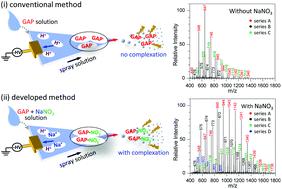Our official English website, www.x-mol.net, welcomes your feedback! (Note: you will need to create a separate account there.)
Metal salt assisted electrospray ionization mass spectrometry for the soft ionization of GAP polymers in negative ion mode.
Analyst ( IF 3.6 ) Pub Date : 2019-10-30 , DOI: 10.1039/c9an01887e Theoneste Muyizere 1 , Yajun Zheng , Hongni Liu , Jia Zhao , Jin Li , Xianming Lu , Daniel E Austin , Zhiping Zhang
Analyst ( IF 3.6 ) Pub Date : 2019-10-30 , DOI: 10.1039/c9an01887e Theoneste Muyizere 1 , Yajun Zheng , Hongni Liu , Jia Zhao , Jin Li , Xianming Lu , Daniel E Austin , Zhiping Zhang
Affiliation

|
Glycidyl azide polymers (GAP) are one of the most important energetic polymers, but it is still a challenge to elucidate their structures using mass spectrometry due to their fragility upon ionization. Herein we developed a soft metal salt assisted electrospray ionization (MSAESI) to characterize directly GAP polymers using mass spectrometry. This technique combines paper spray ionization and the complexing effect of anions from metal salts with GAP in the negative ion mode to softly ionize GAP polymers prior to mass spectrometry analysis. The effects of experimental parameters (e.g., ion mode, applied voltage, and type and concentration of metal salts) have been investigated in detail. In contrast to the positive ion mode, a softer ionization was observed for GAP polymers when the negative ion mode was applied. The radius and average charge of cations and anions in metal salts were found to play crucial roles in determining the performance of the MSAESI analysis of GAP. For a given charge number, a smaller radius of cations favored the soft ionization of GAP polymers (e.g., Na+ > K+ > Rb+), whereas a larger radius of anions led to a preferred performance (e.g., F− < Cl− < Br− < I−) due to variation in dissolution ability. For anions with multiple charges, the ones with fewer charges gave a more favorable ionization to the GAP sample because of their better complexing to GAP molecules than those with more charges in the structure of anions (e.g., NO3− > SO42− > PO43−). According to the experimental observation and evidence from mass spectrometry, we proposed the plausible electrospray mechanisms of MSAESI for GAP analysis with the involvement of metal salts. Moreover, the developed protocol has been applied successfully to the analysis of various GAP samples, and works for other types of sources such as nanoelectrospray ionization.
中文翻译:

金属盐辅助电喷雾电离质谱用于负离子模式下GAP聚合物的软电离。
缩水甘油基叠氮化物聚合物(GAP)是最重要的高能聚合物之一,但由于其在电离时的脆性,使用质谱法阐明其结构仍然是一项挑战。本文中,我们开发了一种软金属盐辅助电喷雾电离(MSAESI),以使用质谱法直接表征GAP聚合物。该技术结合了纸喷雾电离和金属盐中阴离子与GAP在负离子模式下的络合作用,从而在质谱分析之前将GAP聚合物软化。实验参数的影响(例如,离子模式,施加电压以及金属盐的类型和浓度)已被详细研究。与正离子模式相反,当应用负离子模式时,对于GAP聚合物观察到较软的电离。发现金属盐中阳离子和阴离子的半径和平均电荷在确定GAP的MSAESI分析性能中起着至关重要的作用。对于给定的电荷数,阳离子的更小的半径青睐GAP聚合物的软电离(例如,钠+ >ķ + > RB +),而导致了优选的性能(阴离子的较大的半径例如,F - <氯- <溴- <I -)由于溶解能力的差异。对于具有多个电荷的阴离子,用较少的费用的那些,得到更有利的电离到GAP样品,因为它们更好地络合到GAP分子比那些在阴离子的结构(更多的电荷例如,NO 3 - > SO 4 2- > PO 4 3−)。根据实验观察和来自质谱的证据,我们提出了在金属盐的参与下,用于GAP分析的MSAESI可能的电喷雾机理。此外,已开发的协议已成功应用于各种GAP样品的分析,并适用于其他类型的源,例如纳米电喷雾电离。
更新日期:2019-10-30
中文翻译:

金属盐辅助电喷雾电离质谱用于负离子模式下GAP聚合物的软电离。
缩水甘油基叠氮化物聚合物(GAP)是最重要的高能聚合物之一,但由于其在电离时的脆性,使用质谱法阐明其结构仍然是一项挑战。本文中,我们开发了一种软金属盐辅助电喷雾电离(MSAESI),以使用质谱法直接表征GAP聚合物。该技术结合了纸喷雾电离和金属盐中阴离子与GAP在负离子模式下的络合作用,从而在质谱分析之前将GAP聚合物软化。实验参数的影响(例如,离子模式,施加电压以及金属盐的类型和浓度)已被详细研究。与正离子模式相反,当应用负离子模式时,对于GAP聚合物观察到较软的电离。发现金属盐中阳离子和阴离子的半径和平均电荷在确定GAP的MSAESI分析性能中起着至关重要的作用。对于给定的电荷数,阳离子的更小的半径青睐GAP聚合物的软电离(例如,钠+ >ķ + > RB +),而导致了优选的性能(阴离子的较大的半径例如,F - <氯- <溴- <I -)由于溶解能力的差异。对于具有多个电荷的阴离子,用较少的费用的那些,得到更有利的电离到GAP样品,因为它们更好地络合到GAP分子比那些在阴离子的结构(更多的电荷例如,NO 3 - > SO 4 2- > PO 4 3−)。根据实验观察和来自质谱的证据,我们提出了在金属盐的参与下,用于GAP分析的MSAESI可能的电喷雾机理。此外,已开发的协议已成功应用于各种GAP样品的分析,并适用于其他类型的源,例如纳米电喷雾电离。











































 京公网安备 11010802027423号
京公网安备 11010802027423号